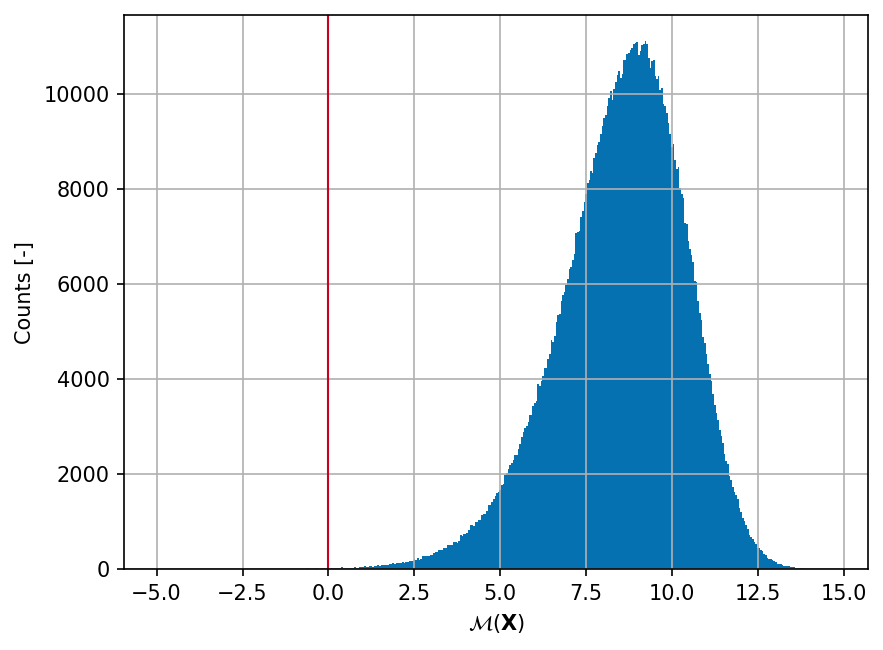Quadratic RS Reliability Problem
Contents
Quadratic RS Reliability Problem#
import numpy as np
import matplotlib.pyplot as plt
import uqtestfuns as uqtf
The Quadratic RS reliability problem is a variant of the classic RS problem with one quadratic term [Waa00].
The plots of the function are shown below. The left plot shows the surface plot of the performance function, the center plot shows the contour plot with a single contour line at function value of \(0.0\) (the limit-state surface), and the right plot shows the same plot with \(10^6\) sample points overlaid.

Test function instance#
To create a default instance of the test function:
my_testfun = uqtf.RSQuadratic()
Check if it has been correctly instantiated:
print(my_testfun)
Name : RSQuadratic
Spatial dimension : 2
Description : RS problem w/ one quadratic term from Waarts (2000)
Description#
The test function (i.e., the performance function) is analytically defined as follows:
where \(\boldsymbol{x} = \{ x_1, x_2 \}\) is the two-dimensional vector of input variables probabilistically defined further below.
The failure state and the failure probability are defined as \(g(\boldsymbol{x}) \leq 0\) and \(\mathbb{P}[g(\boldsymbol{X}) \leq 0]\), respectively.
Probabilistic input#
Based on [Waa00], the probabilistic input model for the test function consists of two independent standard normal random variables (see the table below).
my_testfun.prob_input
Name: RSQuadratic-Waarts2000
Spatial Dimension: 2
Description: Input model for the quadratic RS from Waarts (2000)
Marginals:
| No. | Name | Distribution | Parameters | Description |
|---|---|---|---|---|
| 1 | X1 | normal | [11. 1.] | None |
| 2 | X2 | normal | [1.5 0.5] | None |
Copulas: None
Reference results#
This section provides several reference results of typical UQ analyses involving the test function.
Sample histogram#
Shown below is the histogram of the output based on \(10^6\) random points:
def is_outlier(points, thresh=3.5):
"""
Returns a boolean array with True if points are outliers and False
otherwise.
This is taken from:
https://stackoverflow.com/questions/11882393/matplotlib-disregard-outliers-when-plotting
Parameters:
-----------
points : An numobservations by numdimensions array of observations
thresh : The modified z-score to use as a threshold. Observations with
a modified z-score (based on the median absolute deviation) greater
than this value will be classified as outliers.
Returns:
--------
mask : A numobservations-length boolean array.
References:
----------
Boris Iglewicz and David Hoaglin (1993), "Volume 16: How to Detect and
Handle Outliers", The ASQC Basic References in Quality Control:
Statistical Techniques, Edward F. Mykytka, Ph.D., Editor.
"""
if len(points.shape) == 1:
points = points[:,None]
median = np.median(points, axis=0)
diff = np.sum((points - median)**2, axis=-1)
diff = np.sqrt(diff)
med_abs_deviation = np.median(diff)
modified_z_score = 0.6745 * diff / med_abs_deviation
return modified_z_score > thresh
xx_test = my_testfun.prob_input.get_sample(1000000)
yy_test = my_testfun(xx_test)
yy_test = yy_test[~is_outlier(yy_test, thresh=10)]
idx_pos = yy_test > 0
idx_neg = yy_test <= 0
hist_pos = plt.hist(yy_test, bins="auto", color="#0571b0")
plt.hist(yy_test[idx_neg], bins=hist_pos[1], color="#ca0020")
plt.axvline(0, linewidth=1.0, color="#ca0020")
plt.grid()
plt.ylabel("Counts [-]")
plt.xlabel("$\mathcal{M}(\mathbf{X})$")
plt.gcf().set_dpi(150);

Failure probability (\(P_f\))#
Some reference values for the failure probability \(P_f\) from the literature are summarized in the table below.
Method |
\(N\) |
\(\hat{P}_f\) |
\(\mathrm{CoV}[\hat{P}_f]\) |
Source |
Remark |
|---|---|---|---|---|---|
Exact |
— |
\(2.7009 \times 10^{-4}\) |
— |
[Waa00] |
Annex E.3 Table: Results |
\(12\) |
\(2.6023 \times 10^{-4}\) |
— |
[Waa00] |
Annex E.3 Table: Results |
References#
- Waa00(1,2,3,4)
Paul Hendrik Waarts. Structural reliability using finite element analysis - an appraisal of DARS: Directional adaptive response surface sampling. phdthesis, Civil Engineering and Geosciences, TU Delt, Delft, The Netherlands, 2000. URL: https://repository.tudelft.nl/islandora/object/uuid:6e6d9a76-fd12-4220-9dc1-36515b3f638d.

